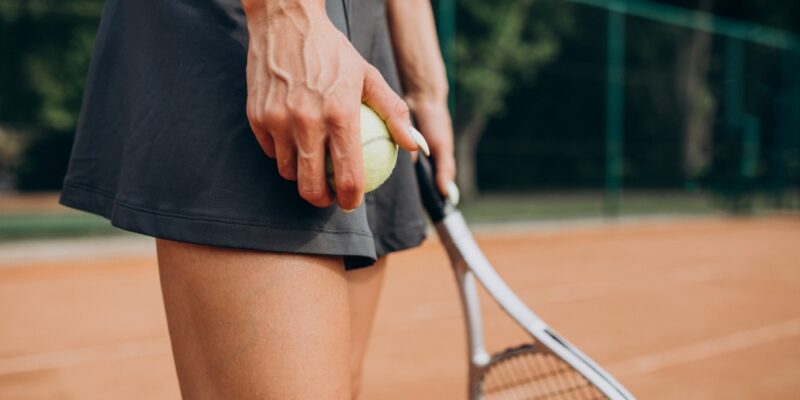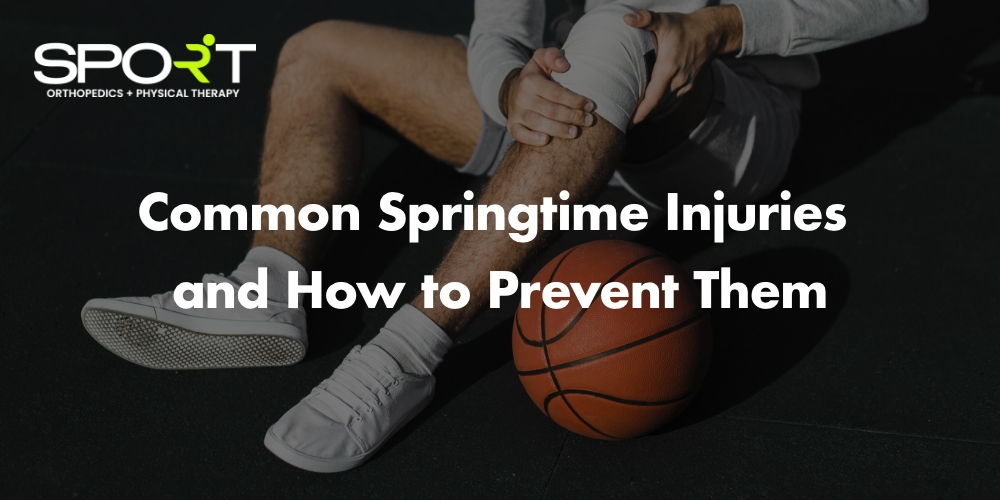Spring is finally here, and that means more time outdoors enjoying activities like skiing, pickleball, and other sports. While staying active is great for your health, it also comes with the risk of common springtime injuries, especially for older adults. At SPORT Orthopedics + Physical Therapy, we want to help you stay pain-free AND injury-free this season. Here are some of the most common springtime injuries and what you can do to prevent them.
Skiing Injuries

Spring break is a popular time for ski trips, but changing snow conditions can increase your risk of injury. In the mornings, slopes tend to be icy, making falls more severe. By the afternoon, melting snow can change your speed unpredictably. Common skiing injuries include:
Knee Ligament Tears: The ACL (anterior cruciate ligament) is especially vulnerable when skiers lose control, twist awkwardly, or land improperly from a jump. A torn ACL can cause instability, swelling, and difficulty walking.
Shoulder Injuries: Falling on an outstretched arm or colliding with another skier can result in dislocations or rotator cuff tears, leading to significant pain and restricted mobility.
Wrist Fractures: Many skiers instinctively extend their hands to break a fall, which can cause wrist fractures that require weeks of immobilization and rehabilitation.
Prevention Tips
Make sure your bindings are set according to your skiing ability, known as your DIN settings. Setting them correctly helps the ski release if it gets caught, decreasing the chance of injuring your knee. The DIN settings are set based on the binding manufacturer’s height, weight, and your skiing ability. Make sure you provide accurate information. Always err toward a lower DIN setting if you aren’t sure.
- Strengthen your legs and core before hitting the slopes to improve stability.
- Always warm up before skiing to loosen up muscles.
- Wear wrist guards and properly fitted boots to help reduce impact injuries.
- Learn how to fall correctly to minimize harm—try to land on your side rather than your hands.
Pickleball and Tennis Injuries

Pickleball has exploded in popularity, particularly among older adults. While it’s a fun and social sport, it can also lead to common springtime injuries if you’re not careful. One of the most common issues is lateral epicondylitis, otherwise known as tennis elbow, caused by repetitive stress on the forearm muscles. Other frequent injuries include:
Knee Strains: The constant stop-and-start movements can put excess stress on the knee joints, potentially leading to sprains, ligament damage, or worsening arthritis symptoms.
Ankle Sprains: Quick lateral movements, sudden pivots, or an uneven playing surface can cause ankle ligaments to roll and stretch beyond their normal range, leading to swelling and instability.
Lower Back Pain: Repetitive bending and twisting motions can strain the muscles and ligaments in the lower back, particularly if core strength is lacking.
Prevention Tips:
- Warm up with stretching and light cardio before playing.
- Strengthen your forearm muscles to prevent tennis elbow.
- Use proper footwear with good arch support to reduce the risk of falls.
- Modify your playing style—avoid overextending your arm on swings.
- Strengthen your core to better support your lower back.
Springtime Sports: Stay Active Without Injury

As the weather warms up, many people return to outdoor activities like jogging, cycling, or golf. While these are great ways to stay active, they also come with injury risks such as:
Achilles Tendonitis: Overuse of the calf muscles during running or jumping sports can lead to small tears and inflammation in the Achilles tendon, causing pain at the back of the heel. If untreated, it may progress to a rupture, requiring surgical intervention.
Golfer’s Elbow: Similar to tennis elbow but affecting the inner part of the elbow, this condition is caused by repetitive gripping, flexing, or swinging motions. It can lead to persistent pain and weakness in the forearm.
Hip and Lower Back Pain: Increased outdoor activity without proper conditioning can lead to stiffness, muscle imbalances, or even sciatica, which causes radiating pain down the legs.
Prevention Tips:
- Gradually increase activity levels instead of doing too much too soon.
- Strengthen muscles that support your joints, particularly the core and lower body.
- Pay attention to any pain—ignoring discomfort can lead to more severe injuries.
- Stay hydrated and practice proper form in all sports.
Recover Like the Pros
Don’t let pain sideline you this spring. Whether it’s a skiing injury, tennis elbow, or a strain from your favorite sport, the right care can make all the difference. At SPORT Orthopedics + Physical Therapy, you’ll get the same expert treatment trusted by professional and elite athletes. Our specialists will create a personalized recovery plan to help you heal faster, move better, and stay active—without lingering pain holding you back.



